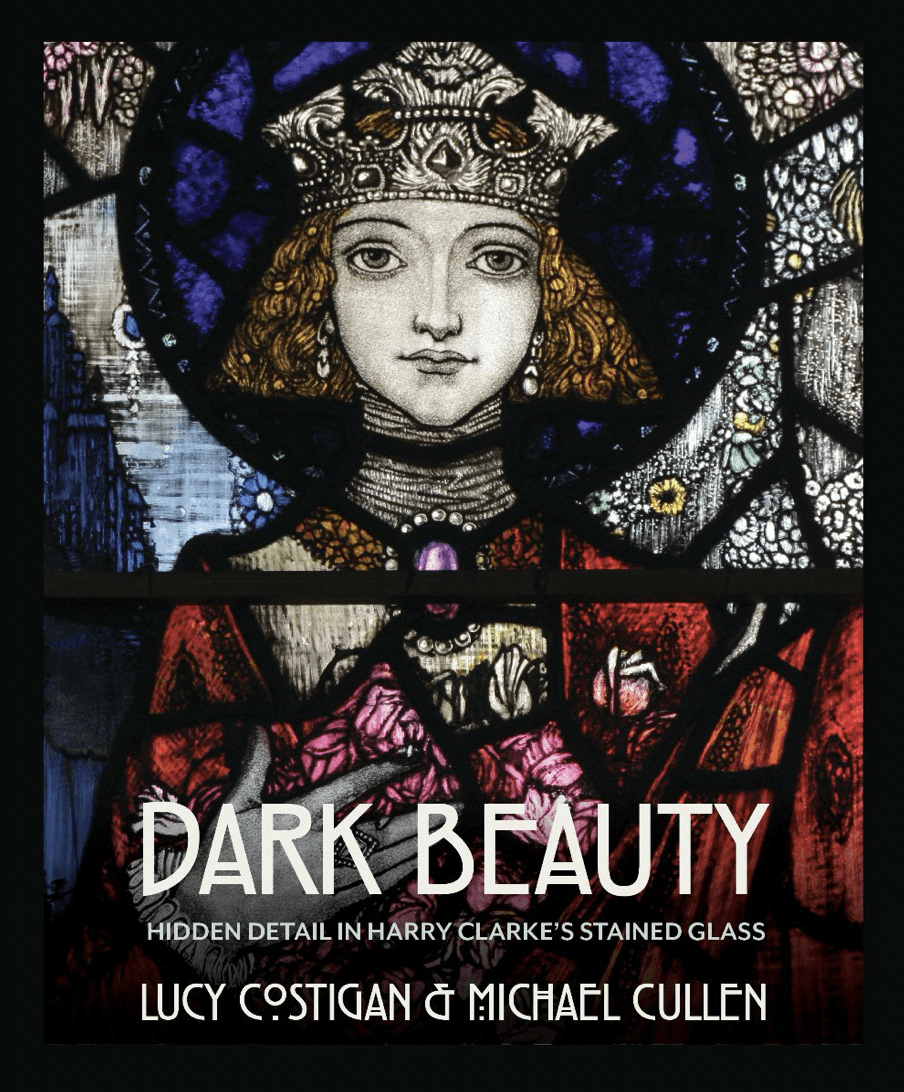Dark Beauty – Hidden Detail in Harry Clarke’s Stained Glass by Lucy Costigan and Michael Cullen, Merrion Press, £24.99.
AN old definition of prayer stated that it was ‘the raising up of the mind and heart to God’. As such nowhere are the conditions conducive to this definition of prayer met than in Gothic cathedrals with their loftiness and upward vertical structure and thrust.
Medieval churches are also famous for the richness of their stained glass windows, illustrating biblical stories for a largely illiterate congregation. Chartres cathedral in France and Canterbury cathedral in England are exemplary examples.
The 19th century Catholic revival in England influenced a renewed interest in the Gothic style and in the use of stained glass, while the Celtic revival in Ireland (19th/20th centuries) ushered in an interest in Celtic culture to be deployed, inter alia, in the visual arts. The languid mood and undulating lines of Art Nouveau also proved influential.
Harry Clarke (1889-1931) born in Dublin, is one of the finest exponents of stained glass design. Experimental and controversial at times, he received commissions from both the Catholic church and the Church of Ireland as well as for secular projects. Examples of his work are installed in buildings in Ireland, England, America and Australia. He was also an illustrator of books.
As the authors reveal in this informative book on his work he brought an imaginative and magical interpretation to the depiction of both religious and secular themes. His colours are varied and rich (variants of ruby reds and deep blues proliferate) and induce a kaleidoscopic interchange of colour and light. The luminous and shifting nature of his deployment of light contributes to the ‘becoming’ of his stained glass works. The composition of his panels can at times be crowded but more often he retains a harmonising integrity of lines, shapes, colours and forms to exquisite effect.
The nine windows of the Honan Chapel include a number of Irish saints – St Columcille, St Finbarr, St Patrick et al. It was his first major commission, and considered a masterwork, drawing high praise on its technical and artistic originality. Irish writer Edith Somerville pondering the darker elements would comment, ‘In a chapel dedicated to the Infernal Deities they should be exactly right, gorgeous and sinful.’
Clarke was also a successful book illustrator. A fin de siècle ambience permeates his illustrations. While the symbolism of light as a life enhancing force radiates his glass panels, as the title of the book Dark Beauty suggests, the dark side of life is also chronicled by the authors. Deformed, demented, erotic and demonic figures cross-fertilise from his illustrations to his stained glass. For George G. Harrap and Co. he illustrated Goethe’s Faust and for John Lane – The Bodley Head ‘The Selected Poems of Algernon Charles Swinburne’. Both books contain ‘erotic and overtly sexual imagery’. The authors also point out there are examples in his religious windows of ‘depraved, fiendish and distorted’ figures that ‘lurk in the borders or stare out behind the main subjects’ as those in Lusk, Co. Dublin, and the Honan Chapel of St Finbar, Co.Cork.
The nine windows of the Honan Chapel include a number of Irish saints – St Columcille, St Finbarr, St Patrick et al. It was his first major commission, and considered a masterwork, drawing high praise on its technical and artistic originality. Irish writer Edith Somerville pondering the darker elements would comment, ‘In a chapel dedicated to the Infernal Deities they should be exactly right, gorgeous and sinful.’
The Geneva Window was commissioned in 1925 by the Irish government to be installed in the International Labour Building in Geneva. The window illustrated scenes from works by a range of Ireland’s best writers including George Bernard Shaw, Sean O’Casey, WB Yeats, Liam O’Flaherty and James Joyce. Given that both church and state considered the works of Joyce and O’Flaherty immoral and literary censorship had been prevalent, the window was never installed, despite being considered a masterpiece by some critics. It is now on display at the Wolfsonian Museum in Miami, Florida.
For readers in the North of Ireland interested in experiencing his work at first hand the Dominican College Chapel, Belfast, houses a magnificent example of a Rose window by Clarke. There are also decorative windows by him in St Eunan’s Cathedral, Letterkenny as well as windows incorporating the Stations of the Cross in the Basilica of St Patrick’s Purgatory in Lough Derg, Co. Donegal.
The book delves into a range of subthemes and decorative schemes and details – flora, fauna, birds, fashion etc. Bewley’s Oriental Café (1927-28) in Grafton Street, Dublin is a good example where flowers, small butterflies and exotic sea creatures embellish a framework composed of the four classical orders of classical architecture and delight the senses.
For readers in the North of Ireland interested in experiencing his work at first hand the Dominican College Chapel, Belfast, houses a magnificent example of a Rose window by Clarke. There are also decorative windows by him in St Eunan’s Cathedral, Letterkenny as well as windows incorporating the Stations of the Cross in the Basilica of St Patrick’s Purgatory in Lough Derg, Co. Donegal.
Lucy Costigan and Michael Cullen are committed enthusiasts and researchers of Harry Clarke’s work and achievement. The style of writing is descriptive, straight forward, avoiding art jargon. The book is lavishly illustrated with some 300 photographs by Cullen, many focusing in on telling details, allowing close readings. Dark Beauty builds upon and extends the research for an earlier book Strangest Genius by the authors. It is not only a valuable comprehensive introduction to the extensive body of work created by Harry Clarke in such a short life but an indispensable ‘fieldwork’ guide for the more serious student of art, design and architecture.





